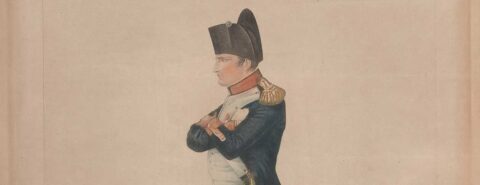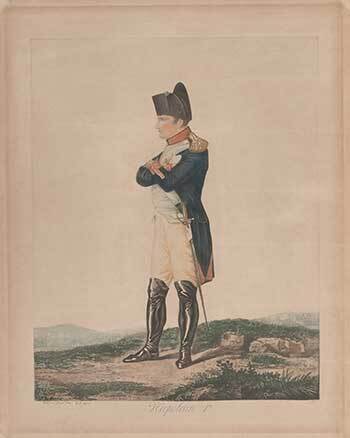Oxford University Press's Blog, page 38
November 22, 2023
Napoleon’s cinematic empire: a fascination with film

Napoleon’s cinematic empire: a fascination with film
People around the nineteenth-century Atlantic world were fascinated by Napoleon Bonaparte. One way to measure this enthusiasm is to look to the poems, novels, plays, paintings, lithographs, souvenir objects, as well as memoirs, histories, and biographies in which he appears. Often, he is front and center, but the emperor also lurks on the margins or pops in momentarily. Some factual, many fanciful, these works created a new kind of Napoleonic empire that continued to conquer the imagination long after his armies disbanded. Indeed, Napoleonic spectacles were a feature of nineteenth-century life, from the Napoleon plays that entertained audiences in cities large and small, the elaborate festivities arranged to honor the return of his body from Saint-Hélène on 15 December 1840—the retour des cendres—or the great parade route at the St. Louis World’s Fair of 1904, where a lounging young Napoleon oversaw the activities.
Given his decided penchant for spectacle—he crowned himself emperor, after all—there is no reason to be surprised that Napoleon’s empire soon included the cinema, a medium his visual ubiquity made ripe for conquest. To prepare for our newest Napoleon, it is worth looking back on some of his prior celluloid incarnations, some great and others less so. Sometimes Napoleon is granted center stage, while other times he tries to steal it, but there is no lack of Napoleon content in the history of film.
“Some factual, many fanciful, these works create a new kind of Napoleonic empire that continues to conquer the imagination.”
Napoleon’s familiarity is key to one important category of movie, what I’ll call the famous people across time film. Whether the goal is plundering historical treasures as in Time Bandits (dir. Terry Gilliam, 1981) or to saving humanity from extermination, the premise of the panned The Story of Humankind (dir. Irwin Allen, 1957), Napoleon inevitably is among the cast of characters. In the best of these movies—Bill and Ted’s Excellent Adventure (dir. Stephen Herek, 1989)—as in Time Bandits, Napoleon is the first historical figure viewers encounter, his familiar face launching viewers into the romps to follow. (Despite the Marx brothers and Dennis Hopper as Bonaparte, there isn’t much of a romp to The Story of Humankind, however.)
 “Napoleon I” by Louis Philibert Debucourt, 1807.
“Napoleon I” by Louis Philibert Debucourt, 1807. Via Wikimedia Commons (public domain).
Poet Pierre-Jean de Béranger penned some of the most famous iterations of a familiar nineteenth-century fantasy: what if Napoleon escaped again? In poems like “Il n’est pas mort” [He is not dead], Béranger gave voice to the collective belief in Napoleon’s ability to defy normal, including mortal, expectations. Alan Taylor’s 2002 The Emperor’s New Clothes updates this genre as it follows Napoleon off St. Helena and into a quotidian, but happy, life. The moments when the fantasy intersect with fact, as Napoleon’s belief that he is Napoleon lands him in a mental asylum, is a fine, ironic touch.
The Napoleonic era provides the backdrop for many movies in which the emperor seldom wanders on stage—Austen, Dumas, and Dickens films, Vanity Fair, various versions of War and Peace—as well as an array of battle movies (Waterloo [dir. Sergei Bondarchuk (1970)], Abel Gance’s Austerlitz (1960), or the more recent Portuguese film, Lines of Wellington [dir. Valeria Sarmiento (2012)]), in which he more often does. But these are less engaging, finally, than the movies about Napoleon that aren’t watchable. The first, with apologies to fans of long silent films, is Abel Gance’s 1927 epic, Napoléon. At 330 minutes, it is an odyssey full of technical innovations, if one can find it.
No matter how hard one looks, however, it is not possible to see what may be the most famous of all Napoleon movies—Stanley Kubrick’s planned, but unmade, Napoleon biopic. Planned around the Felix Markham biography of the emperor, for which Kubrick attained the rights, Kubrick’s screenplay emerged with the aid of a corps of Oxford graduate students, who carefully surveyed Bonaparte and his world. Kubrick claimed there had “never been a good or accurate movie” about Napoleon and his project, no mere “dusty historic pageant,” would fill the gap (The Stanley Kubrick Archive, 787). But it didn’t happen. Still, given that Jack Nicholson was Kubrick’s choice for Napoleon, there are hints of it in both Barry Lyndon, the historical work he made instead which romps into the Napoleonic era, and The Shining, with a deliciously maniacal Nicholson unleashing his own tidal waves of blood. Surely Steven Spielberg version of Kubrick’s plan, currently being created for HBO, won’t be any closer than this combination.
“It is impossible to make a good and accurate movie about Napoleon, a figure weighted with expectations and fantasies and facts and fictions.”
Neither previews nor interviews with Ridley Scott have convinced me, though, that the new Napoleonic spectacle will shake my enthusiasm for a shimmering Cinemascope account of Napoleon’s life and loves, Henry Koster’s 1954 Désirée. Adapted from a best-selling novel of the same title by Austrian author, Annemarie Selinko, Désirée tells the story of Napoleon’s first—and purportedly enduring—love of a young woman from Marseille. To assert that his fleeting romance with Désirée Clary is more important than his subsequent romance with Joséphine de Beauharnais already establishes that this is no documentary, as does its conclusion suggesting that it is Désirée who convinces Napoleon to accept defeat (again) in 1815. Lush cinemascope, brief vignettes, and melodramatic acting all combine to make this movie an odd choice for enthusiasm. Certainly Bosley Crowther, who reviewed the film for the New York Times, thought so. The excellent cast, he sighs, “merely fill out the plushy décor of this Twentieth Century-Fox spectacle, which at times Henry Koster has direct as though it were a satire on suburbia. For the most part, however, he has made it what it is—just a colorful vehicle for a pseudo-Napoleonic outing, a streetcar named ‘Désirée.’” Had Crowther read Ralph Waldo Emerson’s essay on Napoleon he might have realized just how many pseudo-Napoleonic hearts beat in suburbia—and it may well be this aspect of the movie that speaks most powerfully to me.
And then there’s Marlon Brando’s Bonaparte. Juxtaposed against his performance as Terry Malloy in On the Waterfront, Brando’s turn as the emperor is flat, wooden, sometimes silly. If in On the Waterfront, Brando brings to life the frustration of a character who realizes that he could have been somebody, in Désirée he turns to a historical figure who, unbelievably, is not just a contender but an emperor. It may not be a performance to win awards, yet Brando captures the naked ambition and awkward unease that is said to have characterized the young Napoleon off the battlefield. Perhaps Rod Steiger, who plays Joseph Bonaparte, thought so, for he would go on to play Napoleon in Bondarchuk’s Waterloo. It is neither a good nor an accurate movie—but I think it is impossible to make a good and accurate movie about Napoleon, a figure weighted with expectations and fantasies and facts and fictions. So why not have Marlon Brando, in white knee breeches, dancing?
Featured image: “Napoleon I” by Louis Philibert Debucourt, 1807. Via Wikimedia Commons (public domain).
Highfalutin, cowan, and all, all, all… Gleanings at last!

Highfalutin, cowan, and all, all, all… Gleanings at last!
HighfalutinThe OUPblog editor, who has been taking care of this blog for over three years, is leaving the Press, and I wanted to give her a parting present. By chance, an opportunity has offered itself. Mr George Miller of Philadelphia read my old blog post of 8 December 2010 (it is titled “Low-key Thoughts on highfalutin’”) and sent us a letter with a new explanation of the funny adjective. The etymology of highfalutin one can find online is close to his, but he provided a context for the word, and so far, no one has done it: everybody, including me, only played with the form of –falutin(g). If the new explanation, which looks realistic, happens to be accepted, it will be a small step forward in the study of word origins, and what better present can an editor of an etymological blog hope for? A keepsake and the conviction that our work is not bricolage (pottering about with all kinds of bric-a-brac: see the image in the heading!) but an analog of a tree bearing fruit.
Below is Mr Miller’s comment and a letter to me that followed this comment.
Cowan
I came across an article of yours speculating on the etymology of the Americanism “Highfalutin”. I would like to offer a possible etymology that I’ve heard:
As you probably know, the Mississippi was famed for its steamboats. These were large cargo and passenger paddle wheels that generally had 2 smokestacks above their wooden structures.
Coal sparks and embers were of course a fire threat, so various screens and deflectors evolved that returned the ash to the furnace while letting smoke pass. These soon developed quite ornate extensions since they served as advertisements for the elegance of the steamboat itself in a very competitive business. These were “high fluted” smokestacks, like the ones in the smokestack below. In the dialects and accents along the Mississippi (eg., Missouri, Tennessee, Arkansas, Louisiana, Mississippi) I could easily see this being pronounced “Highfalutin”: a high-fluted steamboat is an ostentatious, pretentious steamboat.
I had also read that although it is most likely related to the Mississippi steamboat smokestacks, it may have another explanation: rather than being that those smokestacks were “high fluted”, they were also known as “high flued” since they were quite literally very tall flues.

I had also read that the primary alternative to shipping cargo and passengers on the Mississippi was by river barge. Needless to say, the only advantage of this for a passenger was that it was much cheaper. I suppose they had to sleep on deck, looking up at the richer “high fluted” (or “high flued”) passengers above them, with great resentment of those “high fluted” dandies laughing and looking down on them as they passed by in relative luxury.
The steamboats probably were the first manifestation of industrialization in the interior of the United States and so their smokestacks must’ve seemed quite huge, unique and startling in the mid 1830’s. I would imagine that describing a higher class of people by the smokestacks associated with the steamboats they traveled on would be a natural association for ordinary working people in the towns and cities of that time and place.
My post on the word cowan (4 October 2023) inspired a few “notes and queries.” Before commenting on them, I would like to reproduce part of the entry from the fifth edition of Lexicon on Freemasonry by Albert G. Mackey (Philadelphia: Moss), 1860, p. 99 (I referred to it in the original post but have only recently obtained a copy of the book):
COWAN. One of the profane. This purely masonic term is derived from the Greek kuon, a dog. In the early ages of the church, when the mysteries of religion were communicated only to initiates under the veil of secrecy, the infidels and unbaptized profane were called ‘dogs’… hence… kuon…, the term was borrowed by the Freemasons, and in time corrupted into cowan. The attempt made by some anti-masonic writers to derive the word from the chouans of the French Revolution is absurd.
Mackey quotes from a 1769 text, in which the word cowan occurs: “let cowans do as they please,” but cites no facts in support of his etymology.
Connection between cowan and Gobban the builder (mentioned in a letter to this blog) would also be hard to demonstrate, since cowan refers to an outsider, and the path from the Irish master builder to the term we know does not look straight. Rather (as pointed out in one of the comments), the development might be from “outsider” to a term of abuse. However, the semi-mythic builder was the very opposite of an outsider. In this matter, I would prefer to stay away from Gobban and St. Govan, along with his folklore offspring, and the brave Sir Gawain.
One of our correspondents (she signed her name as Mrs. Cowan) stated that the Cowans were the original wall builders in England but that their knowledge was stolen and put into practice by stone masons. She traces cowan to the “the bloodline, the Cowans.” Cowan is a Celtic name, and this is all I know about the subject. Therefore, I am not in a position to comment on Mrs. Cowan’s statement. I only expect that she can refer to some documents or oral tradition, supporting her claim. When and under what circumstances did the alleged theft occur? Perhaps we’ll hear more on the subject from those versed in the history of freemasonry and of the Cowan family.
 “Hard work is better relish than Worcester Sauce.”
“Hard work is better relish than Worcester Sauce.”By Mark Norman Francis via Flickr (CC BY-NC 2.0 DEED)For dessert
In addition to a huge database and hundreds of folders, I have a sizable archive (a heap of “forgotten lore”): articles about language historians and dictionaries, bits of curious correspondence from old periodicals, and multifarious indexes. This stuff will probably be recycled once I am gone, but so far, I am around and would like to reproduce a report of an amusing incident from The Academy 56, 1899, p. 467. The journal announced a literary competition for “a racy original proverb” (and there was a prize for the best proverb: a guinea). Since for a long time I was busy working on an etymological dictionary of English idioms (the book Take My Word for It is now out), I left this page in my folders. The guinea was divided between two people, but I don’t find the chosen proverbs too inspiring or “racy.” Here they are: “’Just in time’ is the brother ‘Just too late’” and “Hard work is better relish than Worcester Sauce.” Naturally, the Internet is full of images of that sauce (will someone be kind enough to comment on its virtues?).
 “Fall in love with whom you please, but be very careful whom you marry.”
“Fall in love with whom you please, but be very careful whom you marry.”L: Grendel, by Joseph Ratcliffe Skelton, Wikimedia Commons (public domain). R: Magic Circle, by John William Waterhouse, via Wikimedia Commons (public domain)
I liked more some of the other sayings quoted on the page, for example: “The old umbrella seldom gets lost,” “Men should be judged only by their temptations,” “He who carries a guinea in each pocket walks between two friends,” “It is no consolation to get chewed up by a first-class dog,” and especially these two: “No amount of frugality can suffice to a man that has no income” and “Fall in love with whom you please, but be very careful whom you marry.”
Happy Thanksgiving to our American readers and greetings to the rest of the world! For all kinds of organizational reasons, the next blog post will appear in two weeks.
Featured image by Kevin Utting via Flickr (CC BY 2.0 DEED)
November 20, 2023
Catch-22: exploring the escape routes for Gazans

Catch-22: exploring the escape routes for Gazans
Almost as numerous as the missiles and rockets currently flying between Israel and Gaza are the accusations of war crimes, i.e. serious violations of international humanitarian law (IHL): attacks directed against civilians, hostage taking, indiscriminate attacks, disproportionate attacks, attacks on hospitals, violence aimed at spreading terror among the civilian population, starvation, collective punishment, and more. “Crimes against international law are committed by men, not by abstract entities,” but attributing these colossal human sufferings solely or primarily to the criminal behaviour of individuals downplays the serious, complex structural problems that stand behind these individuals. As the UN Secretary General has reminded us recently, war crimes do not “happen in a vacuum.” Even though structural problems do not justify individuals in committing war crimes which must be prosecuted, their prosecution only addresses the symptoms, and only imperfectly, without curing the disease, which requires remedies from other parts of international law. This may be illustrated by exploring the escape routes for the civilians in Gaza who are under heavy bombardment at the time of writing.
On 13 October 2023, Israel called for 1.1 million Gazans to evacuate to Southern Gaza in anticipation of military operation in Gaza City. Some were led onto so-called “safe routes” that were bombed. Others who reached Southern Gaza found themselves still under continuous bombardment. Those who have stayed or returned after fleeing because of the dangerous journey were subject to further bombing, such as the Jabalia refugee camp bombing by Israel, which claims to target senior Hamas leaders following warnings to evacuate civilians since 13 October 2023.
The predominant approach to analyse all these is through the lens of IHL and war crimes, which can connect atrocities to individuals with human faces to assuage the urgent emotional need for accountability. As the UN has observed, the Jabalia refugee camp bombing could amount to the war crime of disproportionate attack for as the ICRC commented, “[i]ncidental losses and damages should never be extensive.” Israel’s expectation that civilians should have vacated the camp following its call for evacuation could indicate that the entire camp area was treated as a single military objective, amounting to the war crime of area bombing. A UN expert has also denounced Israel’s call for the evacuation of 1.1 Gazans as a forcible transfer in violation of IHL and therefore, a war crime.
“This is a wake-up call for us to look beyond IHL … into other bodies of international law.”
It has been debated whether Israel’s original call for evacuation constitutes a forcible displacement in violation of IHL or an advance warning of attack obliged under IHL. IHL even specifically provides for establishing neutralised zone or hospital and safety zones to shelter civilian from the effects of war, and implicitly contemplates evacuation to a foreign country. The potential legality of these escape options under IHL should not, however, detract from the fundamental questions of why anyone should leave their homes to facilitate a military assault, or face a proportionate attack, or be an “incidental loss,” all allowed by IHL. Exploring the escape routes for the Gazans thus presents a catch-22 dilemma: their immediate needs for safety might be met at the cost of even greater peril in subsequent military escalation. This is a wake-up call for us to look beyond IHL, which accepts the armed conflict as is and regulates the conduct of individuals caught up in it, and more deeply into other bodies of international law regulating the structural conditions that make armed conflict and IHL violations within it possible.
The use of armed force in international relations is generally prohibited by the UN Charter except in self-defence. In the mid-2000s, the International Court of Justice has opined on two occasions, one of which related to specifically Israel and Palestine, that armed attacks not attributable to a state do not trigger the right of self-defence. In light of these holdings, Israel’s continuous claim of self-defence in attacking Gaza may be seen as confirming Palestine’s status as a state under international law. If one traces Israel’s occupation of Gaza back to the six-day war in 1967, where Israel used force to “pre-empt” an armed attack that had not actually occurred, Israel’s continuing occupation of Gaza since then becomes itself a continuing armed attack which entitles Palestine to the right of self-defence. Even if Hamas’ 7 October 2023 attack in Israel as an act of self-defence was seen as disproportionate, Israel’s right to defend itself against that attack is limited to the extent necessary and proportionate to halt and repel it. And even if bombing Gaza is somehow seen as necessary to halt and repel the continuing rocket attacks from Gaza that break through Israel’s Iron Dome system, the scale and intensity of the bombardment cannot be considered necessary or proportionate to achieve that goal.
The 7 October 2023 attack was conducted against the background of the persistent denial of the Palestinians’ right to self-determination and long-term, gross violations of civil, political, socio-economic, and cultural rights in Palestine. While the latter do not justify any violation of IHL, they create structural conditions that hinder IHL compliance when conflict erupts. Israel’s tight and illegal land, air, and sea blockade on Gaza to control Gazans’ activities was answered by Palestinian militants’ construction of a labyrinth of underground tunnels network as an all-purpose military compound, which in turn renders the commingling between militants and civilians almost inevitable. Airstrikes by Israel in the tiny, crowded, and sealed Gaza Strip then tend to cause extremely high civilian casualties, generating deep resentment and fuelling militancy, building momentum for fresh rounds of violence that are pre-disposed to violate the UN Charter and IHL. There is no short-cut to curing these “root causes of recurrent tensions, instability, and protraction of conflict,” which would require transforming the structural conditions by fully respecting, protecting, and promoting the human rights of all concerned in accordance with international human rights law.
The Use of Force against Individuals in War under International Law: A Social Ontological Approach is available on Oxford Scholarship Online via institutional access.
Featured image by Chuttersnap via Unsplash (public domain)
November 17, 2023
The art of philosophy

The “philosophy of art” in Anglo-American analytical philosophy has had barely any influence on the main epistemological, ethical, and metaphysical concerns of that philosophy. By setting up a specific domain of questions concerning the ontological status of “art and its objects,” the meaning of “expression,” “do I like it because it is beautiful or is it beautiful because I like it?,” and the like, reflection on whether participation in art might itself be a means of doing philosophy is effectively precluded. For analytical philosophy, art is instead an object to be explained like any other.
In contrast, if one looks at the history of aesthetics in modern philosophy, a central concern is its initiation of new ways of questioning the status of “subjective” and “objective” that are occasioned by fundamental social, economic, and political changes. One manifestation of this questioning is precisely a concern with the potentially damaging effects of an exclusively objectifying stance towards the world, where nature is seen in solely “mechanical” terms, as a system of laws. The dominant philosophical alternative to the emergence of modern aesthetics derives from sceptical questions prompted by Descartes’ attempt to make the subject the ground of philosophy. The ensuing questions have a considerable influence on subsequent philosophy, but, looked at within their historical context, can also seem somewhat puzzling.
At the moment when, not least via figures like Descartes himself, the modern mathematically based sciences begin to produce knowledge claims that generate more and more practically useable results—and plausible explanatory theories—a significant part of modern philosophy consists of repeated, never definitive, attempts to refute epistemological scepticism. This situation is what leads John Dewey to see modern philosophy, in The Quest for Certainty, as involving:
“the complete hold possessed by the belief that the object of knowledge is a reality fixed and complete in itself, in isolation from an act of inquiry which has in it any element of production of change.”
Seeking to ground cognitive relationships to the world in such terms can lead to a neglect of the fact that knowing things is only one of the ways in which we relate to them, and so can distort philosophical interpretations of the world. Further historical changes, which help give rise to the “aesthetic” alternative at issue here, are that the scientific developments are accompanied by the emergence of the modern philosophical concern with art and the beauty of nature; by new conceptions of language that see it as an active part of “human nature,” not as something divinely created; and by the commodification of objects in the new capitalist economy, which changes the very nature of what an object may be. Commodification can be linked to the modern sciences insofar as in both the value of particular things is subordinated to objectifying forms of identification, in the rendering equivalent of objects qua exchange values, and in the form of general scientific laws. The new concern with aesthetics can be construed in part as a reaction to what is neglected by such forms of identification, and this links to a new attention to the manifold ways in which what Cassirer terms “symbolic forms,” which include both language and the arts, constitute the world we inhabit.
If more weight is given to these developments, a different trajectory of modern philosophy emerges. Rather than priority being given to questions of knowledge and the construction of theories in separate epistemological, metaphysical, and ethical domains, in this alternative account the ways in which sense is both made and put at risk when the idea of a “ready-made world” is put in doubt become the main concern. Epistemological scepticism is interpreted in this view as itself a symptom of a wider concern in modernity with “meaning,” as what connects us to a post-theological world and makes things matter. An epistemological response to this is seen here as inherently one-sided because it gives primacy to an observational stance that involves a scepticism-inducing separation of subject and object, whereas our main mode of existence is actually through active participation in the world, in which global sceptical doubts play little, if any, role. Hubert Dreyfus and Charles Taylor refer to “contact theories” in this respect, as opposed to “mediational theories” of the kind that result from the perceived subject-object split.
“The arts can in significant respects be seen themselves to be philosophical.”
The “aesthetic dimensions” become manifest when the world is regarded as a shifting context of meanings, rather than as the totality of knowable objects. This is why the associated changes in conceptions of nature, that occur from the latter half of the eighteenth century onwards, are linked to fundamental changes in how language is conceived. From being that which designates things in a pre-existing world order, it becomes what constitutes a world of meanings. Cassirer suggests that language is now not primarily to be thought of in terms of logic, but rather in terms of aesthetics, because particular languages and forms of language give rise to differing kinds of understanding, expression, and articulation. The world in this sense can now be seen, for example, through ways in which participation in music may alter how we relate to it. This is reflected in the simultaneous change in status of music in the eighteenth century that meant it was no longer just attached to religious ritual or a mere accompaniment to social activities, and—as the rapid development of music from Bach to Schoenberg shows—explores how what previously made no sense can make sense in new musical configurations. At the same time, the world is also what is fundamentally transformed when commodification changes the very sense of what objects are. Attention to ways in which the ensuing objectification and obscuring of the particular value of things can be questioned are crucial to the role of the arts in constituting new perspectives on nature in modernity.
Most importantly, the changes at issue here mean that the arts can in significant respects be seen themselves to be philosophical. If modern philosophy seeks to make sense of the world without relying on metaphysical guarantees, the arts can be regarded as forms of philosophical practice. Alva Noë asserts in Strange Tools that art “is itself a mode of investigation, a style of research, into the crucial questions that interest us, e.g. our human nature.” It is obviously not the case that participation in the arts therefore results in epistemological, metaphysical, ethical, or theoretical arguments. Through what the early German Romantics saw as its “infinite interpretability,” art responds instead to the always partial nature of our takes on the world and creates new ways of participating in the world. Given that philosophical theories almost constitutively fail to achieve the kind of consensuses that form much of the basis of the modern sciences, and are therefore inherently provisional, exclusion of the arts from philosophy is essentially a form of dogmatism. As I try to show in Aesthetic Dimensions of Modern Philosophy, exploring these issues points to the need for a philosophical approach that sees the arts themselves as philosophical resources, and in which the aesthetic implications of the work of thinkers as diverse as Montaigne, Hume, Kant, Schelling and the early German Romantics, Hegel, Marx, Nietzsche, Cassirer, Karl Polanyi, Wittgenstein, Heidegger, Dewey, and Adorno, can reveal neglected or repressed dimensions of a world in which so much is now in question.
November 15, 2023
Five unexpected things about medical debt

Five unexpected things about medical debt
Debt is a subject that so many of us dread. It is a drain not only on our wallets but also on our minds, leaving us with the sense that our lives and our freedom are being slowly drained away. The consequences of medical debt, which is held by 100 million Americans, are even worse. Medical debt causes people to forgo (or be denied) necessary medical care, harms people’s credit, and leaves their property (including their bank accounts and even their homes) vulnerable to foreclosure.
In Your Money or Your Life: Debt Collection in American Medicine, I detailed some odd particularities about medical debt. Here are five:
1. Your medical debt can land you in jailDebtors’ prisons have been illegal in the United States for centuries, but Americans are still jailed because of medical debt. If hospitals and their debt collectors decide to sue a patient for medical debt and win the judgment, a patient might be summoned to court for a hearing to “discover” where their assets are located. If a patient fails to appear in court for an oral examination as part of this process of discovery, the creditor can request that the court issues a “body attachment” directing the sheriff to arrest the debtor. Technically, the debtor is being arrested for contempt of court, not the debt itself, but the debt is the fundamental cause of the arrest.
The American Civil Liberties found that in 2020, 44 states still allowed the arrest of a debtor for failing to appear in court or failing to provide information to creditors after a judgment against them. Medical debtors are frequent victims of this practice. In Idaho, for instance, Medical Recovery Services LLC sought and obtained the arrest of more debtors than any other collector in the state between 2010 and 2016. In one case, a judge set bail at more than twice the amount of the debt. After being arrested for failing to appear for a hearing in Utah for unpaid debt for an ambulance ride, Rex Iverson was arrested and brought to the county jail. Later that day, when the police went to check the holding cell, they found Iverson dead; a subsequent investigation determined that Iverson had committed suicide by strychnine poisoning.
2. Hospitals can wipe away your bill before you see the doctorTo receive a tax exemption, every nonprofit hospital in the United States must have a financial assistance policy. These policies specify income qualifications for free and discounted care. But even if patients qualify for this “charity care,” they are usually made to complete onerous and detailed applications. But there is an easier way. Hospitals can use existing “presumptive eligibility” software to determine, at the point of care, whether a patient is likely to qualify for financial assistance. This is relatively easy to determine; for instance, if a patient is enrolled in food stamps, they meet eligibility criteria for most hospitals.
At Oregon Health and Sciences University in Portland, Oregon, the billing department started this using this software in 2017. Since instituting this process, patients have been offered free care earlier in the process, and the billing department no longer has to deal with as many incomplete applications.
Still, this effort to bring some efficiency and equity to billing is still not common practice. Hospitals must pay every time they use proprietary software to screen a patient. Most hospitals would rather not bother with the expense, so they leave the onus on patients to apply for financial assistance.
3. Medical debt is bought, sold, and collected by some of America’s wealthiest and most powerful peopleThe medical debt collection industry includes some of the world’s richest and most powerful people. In 2014, medical debt collector Transworld Systems was sold to a private equity firm called Platinum Equity. This firm was headquartered in Beverly Hills and owned by billionaire Tom Gores. As of July 2022, Gores was the 424th richest person in the world, just behind Twitter founder Jack Dorsey and Star Wars creator George Lucas. Gores is best known as owner of the NBA’s Detroit Pistons, and as a philanthropist. He is a member of the Board of Directors of the UCLA Medical Center, a donor to Children’s Hospital Los Angeles and to various causes Detroit and Flint, Michigan, where he grew up. He is a giant of industry, and a fixture in the civic life of two great American cities.
Under Gores’ stewardship, Transworld Systems Inc. was not nearly so charitable as his public image. By 2017, it was the company with the most medical debt collection complaints on the CFPB’s database. One person in Georgia claimed that TSI had called a friend to find him (which is allowed), but during that call had said it was in regard to a medical debt that he owed (which is not). A resident of Illinois complained that a negative action had been filed on his credit report by TSI for a medical debt that he had never heard of, and was sure he did not owe. He said he had tried to call TSI numerous times to settle the matter but could never get anyone on the other end of the line. Another in Missouri claimed that TSI called his work cell phone so often, and despite his pleas to them to contact them at home instead, that his supervisor became annoyed and passed him over for a pay raise.
4. Aggressive debt collection earns hospitals very little moneyNot all hospitals are in financial trouble. In 2019, America’s hospitals recorded their highest average profit margin ever, at 6.7%. And while many hospitals struggled during the early days of the COVID pandemic, massive federal support led them to finish the year with similar profit margins as in 2019. Of course, there are many hospitals that do not operate with such comfortable margins; many struggle to stay afloat, and each year, some close.
But hounding patients who cannot afford to pay does precious little to help. TransUnion Healthcare reports that in 2016, 68% hospital bills of bills under $500 were not paid in full. Heftier bills were even less likely to be paid; 99% of hospital bills over $3,000 were not paid in full in 2016. This meager repayment is the reason why when hospitals sell their debt to outside buyers, they receive mere cents on the dollar. Most patients in arrears just don’t have the money to pay without risking their financial health, a problem that has given rise to a saying long in use among hospital administrators: “self-pay equals no pay.”
Suing patients does not meaningfully contribute to a hospital’s financial well-being. A study of Virginia hospitals that garnished the wages of patients found that they collected, on average, 0.1% of hospital revenue through this practice. Even the hospital that sued the most patients in the state, Mary Washington Hospital in Fredericksburg, gained only 0.2% of its revenue from wage garnishments. And most often it is not the struggling safety-net or rural access hospital filling the court dockets. Institutions that pursue patients as aggressively as possible frequently have comfortable operating margins and very well-paid executives.
5. Widows and widowers are being held responsible for repaying the debts of their late spousesThis strange fact is the result of a tangled legal history. Every state law includes a “doctrine of necessaries,” which makes parents liable for the support of their children; they must, in other words, provide what is “necessary for the health and well-being” of their children. In some states, however, this doctrine is also held to make spouses liable for the financial support of one another. This does not exist everywhere: in some states, such as Georgia, the spousal doctrine of necessaries has been repealed by the legislature, while in others, such as Florida, it has been ruled unconstitutional by the courts. But in states where the spousal doctrine remains, hospitals have used it to sue spouses when the patient has died before paying their bills. In fact, medical debt is the predominant kind of debt for which the doctrine of necessaries is invoked.
The doctrine of necessaries is a relic of early English common law in which women had no right to own property or assume debts independent of their husbands, so husbands were deemed to have an obligation to pay the necessary expenses of their wives. In an ironic interpretive move, given the burden it places on widows and widowers, the very fact that medical care is so necessary is what makes it so easy for hospitals to invoke the doctrine in court.
Widows have even been made to do manual labor to pay off the debts of their late spouses. Grieving the recent death of her husband after a prolonged hospitalization, Ms. Wilson faced medical debt she could never hope to repay on her fixed income. In 1995, Danville Regional Medical Center in southern Virginia gave her the option of entering a “Service-Credit” program, where patients owing between $300 and $20,000 were put to work typing, filing, housekeeping, lawn care and working in the print shop. For their labor, they earned $5 per hour toward settling their debts. “Net pay is applied directly to the bill, so no cash changes hands,” explained a rather upbeat front-page article in the Richmond Times-Dispatch. Nowhere in the article was the possibility mentioned that the medical center, a non-profit, might just write off the unpaid debts of low-income patients as charity care. The journalist called the program a “working cure,” without a hint of irony.
The road aheadThe history recounted in Your Money or Your Life shows how medical debt transformed from a personal negotiation between doctor and patient into an impersonal financial instrument, bought and sold by people with no role in patient care and no social bonds to patients. Hospitals and their debt collectors have become aggressive in pursuing debts, threatening patients’ physical and financial health. There have long been people working to alleviate the suffering caused by medical debt, as well as abolitionists who aim for an America where such debt is a thing of the past. By better understanding how medical debt came to be so pervasive and so harmful to patients, we might help that day come sooner.
Featured image by camilo jimenez on Unsplash (public domain)
From broke to broker: following the tortuous path to truth

From broke to broker: following the tortuous path to truth
Broke (as in I am broke) is a variant of the past participle broken. No one seems to know why this n-less form has survived. The manuals I have consulted pretend that the problem does not exist. Written, chosen, spoken, swollen, beholden, and even the American form gotten have preserved their final n. Only broke competes with broken. Yet today, our main question is whether broker is some variant of breaker. Unlike so many nouns, adjectives, verbs, and conjunctions I have discussed in this blog, broker is no longer a word “of unknown (uncertain, contested) origin,” but even though the riddle has been solved, it is instructive to see how after many false moves the solution was eventually found.
It is hard to decide to what extent non-linguists (the majority of the world!) are interested in both learning the truth and in following the tortuous path to it. To me, the history of etymologists’ wanderings reads like a thriller: so many naive and clever suggestions, such a blend of ignorance and ingenuity! And those who have followed this blog for some time will remember how often I can only offer the shortest history of the question, rather than a solution. Moreover, we’ll never know the origin of many words, so that the end of the way may be a blind wall.
 Broke but unbroken.
Broke but unbroken.Photo via Pexels (public domain)
Broker surfaced in English texts in the fourteenth century, that is, in the days of Chaucer, and this fact alone suggests that such a business term is more probably French than native English, but the temptation to connect it with break misled numerous researchers, though, regardless of our views on securities and usury, what do or did brokers, stockbrokers, and pawnbrokers “break”? Below are a few samples of the earliest guesses: brokers, one reads, received their name after break, because only bankrupts were in former ages permitted to be of this trade (!). Or is broker a contraction of procurer? A much more reasonable hypothesis connected broker with French brocanter “to deal in second-hand goods.” We find this etymology in James Stormonth’s otherwise excellent English dictionary.
Middle Dutch brak “worthless” and Russian brak “damaged goods” (both eventually derived from Dutch breken “to break”) have also been suggested as the etymons of broker. Those were unprofitable hypotheses. The adventurous but usually reasonable Hensleigh Wedgwood devoted a whole page in his etymological dictionary to a tie between broker and Russian brak and its cognates elsewhere. Wedgewood’s learned contemporaries were so puzzled by his hypothesis that they at best cited it, without even minimal discussion, and William W. Skeat only wrote: “I dissent from Wedgwood’s opinion.” Yet this etymology survived all four editions of Wedgwood’s dictionary. Scholars are stubborn people.
The German for “broker” is Makler (again from Dutch; the root is related to English make). Attempts to find a semantic bridge from broker to Makler also proved futile. Even English brock “badger,” about which so much was written in the post on brocard (25 October 2023), has been pressed into service. Skeat, at a loss for a better solution, referred the root of broker to the Dutch cognate of English brook “to enjoy; put up, endure” (both Dutch bruiken and German brauchen “to use” are related to English brook; the verb seems to be obsolescent, to use a rather rare and bulky adjective).
This etymology is wrong, and eventually Skeat conceded defeat, but he did not like to surrender (scholars are stubborn!), and in the last edition of his dictionary, he, almost grudgingly, accepted the truth. However, in the 1911 A Concise Etymological Dictionary of the English Language, he wrote everything clearly: broker derives from Middle English brocour “an agent, witness of a transaction,” from Anglo-French brocour, an agent; originally a “broacher” or “seller of wine.” Late Latin broccātor “one who broaches,” from Late Latin bocca, that is, “spike” (see brooch). A few other late dictionaries say the same: “Middle English brocour ‘pedlar [that is, peddler], pawnbroker’; loanword from Old French brocour, brockeor ‘tapster who retails wine from the tap’”—and refer the reader to the words given under broach. This last reference is misleading (see below). The connection between broach and selling wine was first established in the OED.
 “Long, long afterward, in an oak / I found the arrow, still unbroke.”
“Long, long afterward, in an oak / I found the arrow, still unbroke.”Photo via Unsplash (public domain)
This is all very good, but we are still left wondering how a seller of wine reached the status of a broker. Fortunately, the answer is not unknown. Throughout the Middle Ages, the duties of a broker, that is, a person who negotiated deals, were closely connected with serving guests and dispensing wine (the whole of the “entertainment industry”). The same holds for the medieval “factor” (French facteur). Curiously, French facteur “postman/mailman” reminds one of courtier “broker” and “one doing a lot of running around” (so explained by Leo Spitzer). Thus, though from an etymological point of view, a broker is a seller of wine, his duties went far beyond what his name suggests. The path was from “taverner, tapster, publican” to “middleman.” In the heading you saw an ideal blend of a tapster and a potential broker. (Note that in Roman and biblical days, a publican collected taxes, rather than owning a pub!).
Nor is the distant origin of the Anglo-French abrocour (1285) a riddle. It was solved by A. L. Mayhew in a contribution to Notes and Queries (11/VI, 1912, p. 126). The root broc, he suggested, “is of Semitic origin,… from a Hebrew source, the Hebrew word having been introduced into Western Europe through the commercial activity of the Moors of Spain.” Spanish alboróque meant “a gratuity given to one that makes up a bargain between two, in the nature of Brokeridge…. The word boroc traveled to England by Provence, and the Hebrew word bêrêk ‘blessing’ is related.” The Oxford Dictionary of English Etymology (1966) mentions the Semitic hypothesis but stays short of endorsing it. I don’t think there is any need to be cautious here.
 Clever brokers sometimes cause breakers in the ocean of finance.
Clever brokers sometimes cause breakers in the ocean of finance.(L: Pexels – public domain. R: Wikimedia Commons – public domain.)
Now back to broach and brooch. If the French source of broker should be sought in Hebrew and if, therefore, it has nothing to do with piercing, then there is no connection between it and English nouns broach and brooch, both of which are derivatives of Old French broche “spit.” Its source must have been brocca “spike.” It is a mere vagary of Modern English spelling that broach and brooch are spelled differently. (This is not the best place to broach the subject of English spelling. I hope it will be reformed some time in the future.) The idea of a sharp object underlying the root of broach and brooch can also be detected in broccoli, brochure, and bracket.
To return to the beginning: so many “issues”! Broke (as in go broke) without final n; publicans becoming middlemen; serving wine without piercing the barrel; broach confused with brooch, and travels from Hebrew to Romance and finally to English. Such is etymology at its best. As a true broker, I say “Enjoy!”
Featured image by Robert Wallace via Flickr (CC BY-NC-ND 2.0 DEED)
November 14, 2023
The risks of boosterism in research writing

The risks of boosterism in research writing
At first glance, the significance of a piece of research may not be obvious, either from a paper submitted to a journal or from a published article. Its novelty, importance, and future impact are often uncertain, needing time to become clear to the research community.
To improve the reception of your own work, you may be tempted to point out one or more of its virtues within the paper itself. This kind of positive self-evaluation or boosterism (a word with a surprisingly long history) may be viewed more negatively by the intended audience.
NoveltyBy default, reported research is expected to be original. Announcing its newness or novelty can irritate readers, who find it unnecessary and self-promotional, making them less likely to read on.
Here are some examples: from an engineering article, “we believe that this work is the first in the literature”; from a medicine article, “We show for the first time”; from a materials science article, “Our unique approach”; and from another medicine article, “A further novel finding.”
Of course, in some circumstances such claims are justified, as in Watson and Crick’s introduction to their 1953 Nature article on DNA, which led to the award of the Nobel Prize with Maurice Wilkins:
This structure has novel features which are of considerable biological interest.
Since then, the use of “novel” has become much more common in the literature. A quick analysis with Elsevier’s Scopus database suggests a roughly 200 times increase in its frequency of occurrence in research abstracts.
This inflationary effect may also be found within individual articles. For example, in one engineering article, “novel” occurred eight times, as in “novel approach,” “novel finding,” “novel framework,” and so on.
Some journals now ban claims of novelty, and priority too.
ImportanceIn the spectrum of research activity there’s a place for incremental work, but most journals prefer something more substantial. The importance of the work should, however, be evident from the findings and the context. Authors’ unsupported claims may fail to convince readers, who are aware of the potential conflict of interest.
Here are some examples: from a physics article, “Our results are important for a variety of natural and industrial settings”; from a chemical engineering article, “This exciting result provides a strategy”; and from a medicine article, “This result is significant, both from a theoretical and from a practical point of view.”
Unfortunately, objective recognition of these particular claims has not, so far, followed, at least as measured by the number of times other authors have cited the articles. According to Scopus, each has averaged no more than one citation a year over several years, below the expected rate for their research fields.
Promoting other researchers’ findings is another matter, but it too can sometimes lead to escalation. In one psychology review article the word “important” occurred over 50 times in one form or another, as in “important differences,” “important subgroup,” “important tasks,” “important question,” “important correlate,” “important link,” “important implications,” “important weaknesses,” “important advances,” “important context,” “important variables,” and so on.
Excessive promotion, as with excessive caution or hedging, may shift readers’ expectations, so that anything that isn’t labelled important becomes unimportant.
Future impactSome research achieves impact only in the longer term, for example, by improving experimental methods or revealing new areas of study. Although predicting future impact is even more hazardous than claiming it for the present, occasionally authors succumb to the opportunity.
Here are some examples: from a materials science article, “we believe these results will have immense practical interest;” from an engineering article, “We believe these results will ultimately answer the questions;” and from a computer science article, “this paper will guide future researchers.”
According to Scopus, each of these articles averaged fewer than two citations a year over several years, though this isn’t to say that some won’t eventually achieve greater impact.
Happily, some authors’ predictions do prove correct. This statement appeared in a 2007 computer science article:
We believe that our results are of both theoretical and practical importance because they open up completely new avenues …
Citations quickly reached over 150 a year, two orders of magnitude greater than with the earlier examples.
With these differing citation rates, it may be hard to decide whether predictions help recognition. But there’s another consideration that points to more harm than good.
Take these two scenarios. First, suppose your article proves a success. Then any claims of future impact may, in retrospect, simply look insightful to readers but add little to the standing of the work. Second, suppose your article doesn’t prove a success. Those contradictory claims may then appear ill-judged and, by association, weaken the authority of the work even further.
If, after all this, you still want to add a prediction, look at Watson and Crick’s hedged phrasing in the conclusion to their Nature article:
It has not escaped our notice that the specific pairing we have postulated immediately suggests a possible copying mechanism for the genetic material.
Understatement, especially when the outcome is rather less assured, has the advantage of accommodating either the article’s success or lack of it, without reflecting on the work itself. But the degree of hedging needs care. Too little is pointless, too much looks insincere.
Alternatively, you can just avoid boosterism, in all its forms.
November 12, 2023
Seven predictions for the biggest management trends in the next few years

Seven predictions for the biggest management trends in the next few years
In August 2023, OUP attended the Academy of Management Annual Meeting in Boston. We asked attendees what they predicted the biggest trends in management will be in the next few years and received some great answers focusing on different areas of management.
What do you think will be the next big management trend? Read on for the top seven predictions from the Annual Meeting and share your own ideas in the comments.
1. Digital transformationBusinesses are undergoing digital transformations to increase efficiency and modernise operations and workflows. New technologies are becoming increasingly popular such as automation, AI, and cloud computing.
2. Change of generations for workers and leadersThe changing of generations is an emerging management trend that recognizes the evolving dynamics within the workplace as different generations coexist and collaborate. This trend emphasises the importance of understanding and leveraging the unique strengths, preferences, and communication styles of each generation to foster a more inclusive and productive work environment.
3. The increase of Artificial IntelligenceThere were a few iterations of this response, including “AI-augmented innovation and strategy” and “leveraging AI to reduce carbon emissions.” Even though these are tackling different aspects of management, it seems inevitable that business leaders will have to consider how to integrate AI into operations to help employees.
4. Sustainable green organizationsSustainability has been a hot topic for the last few years, but businesses are now focusing on making real action. New sustainability roles are being created specifically to manage this focus, providing reporting on the status of businesses and what actionable steps need to be taken.
5. Flexible workingIn the post-pandemic world, flexible working has become increasingly popular. Businesses have invested time into improving the employee experience by finding the right balance of home/office working.
6. Artificial Intuition—the ultimate AI?As artificial intelligence becomes more and more sophisticated, it can perform many of the mental tasks that were previously carried out by humans. However, intuition is one area where humans will continue to add value to business in areas such as judgement and creativity that cannot yet be replicated by a machine. This makes intuition a valuable skill to be developed and prioritised in the age of artificial intelligence.
7. Data-driven project managementAll organisations deal with copious amounts of data every day. It makes sense to use that data to drive decisions. Data analytics can help to measure success, room for improvement, optimise operations, and much more.
What do you think is the next big management trend? Share your predictions in the comments!
Featured image by Jo Szczepanska from Unsplash (public domain)
November 10, 2023
Why global museums amassed the ancestral dead, starting in Peru

Why global museums amassed the ancestral dead, starting in Peru
It is a time of worldwide reckoning for museums that display or contain ancestral dead.
Although scrutiny of looted art dates to Britain’s 1816 inquest over the Parthenon marbles, it has taken far longer for museums of anatomy, anthropology, and natural history to address their “specimens” of peoples killed, disinterred, and dissected in colonial contexts. The dam broke in the 1980s, when Native North Americans pressed the U.S. Congress to pass two acts that required museums receiving federal funding to notify descendants of the ancestors in their collections and attempt their “repatriation.” Museums exploited the laws’ loopholes leading descendants and decolonizing nations around the world to press for wider returns. In 2020, the global George Floyd protests extended to the museums and monuments that had their origins in scientific racism, settler colonialism, and the afterlives of slavery. Here in Pennsylvania, where I write, Finding Ceremony is working for the descendant-controlled rehumanization and return of the skulls of black Philadelphians collected by the white supremacist Samuel George Morton, today possessed by the University of Pennsylvania.
Why, though, did museums and scholars systematically amass the dead to begin with? In the early nineteenth century, prominent anatomists like Johannes Friedrich Blumenbach collected skulls but were satisfied with exemplifying their physical differences via the discussion of single types (a “Tungusae” skull to represent the “Mongolian” or “yellow race,” for example). A century later, institutions sought as many crania as they could. To explain that difference, historians and critics of bio-racism observe that the nineteenth century was European colonialism’s high watermark, and that anatomists like Morton used the settler violence and disinterment that it caused to prove the unprovable—that the collection and measurement of more and more crania could establish the existence of separate and unequal races.
But the specific story of the collection of Andean ancestors charts a different origin for this global process, and it asks us to think with more nuance regarding what to do with the museums it created. Using scholarly publications from the sixteenth to twentieth century, and the correspondence and fieldnotes of anatomists and anthropologists in at least 26 museums and archives in Peru, the United States, Spain, and Great Britain, Empires of the Dead offers four new ways of thinking about that story, and why it matters.
1. The European collection and display of the non-European dead began in sixteenth century Peru, inspiring the global invention of “mummies.”Although Europeans examined the Indigenous dead since Columbus’s second voyage, in 1493, it was Spain’s encounter with Tawantinsuyu, the Inca empire, that led to the invention to “ancient” and racialized human remains as a scientific category. In Tawantinsuyu, Spaniards met the Incas’ own hierarchy of sacred and well-preserved ancestors and in 1559 tried to conquer them by displaying them as objects of anatomical knowledge. Besides illustrating how the collections of other peoples’ ancestors has always been about violence and science, this early museumification of Inca and Andean ancestors had global consequences. By the eighteenth century, European scholars conjectured that the Incas, and not just the ancient Egyptians, made “mummies,” and that the Americas’ racialized past might be studied using Peru’s pre-colonial dead.
2. South American patriots encouraged the Andean dead’s collection and study for their own scientific and nationalist reasons.This “mummification” of the Andean past mattered to Peru. In 1821, shortly after declaring Peru’s Independence, the South American patriot José de San Martín sent King George IV of England an “Inca mummy,” hoping it would enter the British Museum. Over the next century, thousands of “ancient Peruvian” mummies and skulls followed, in part because republican Peruvian scholars and collectors studied the Andean dead in the belief that they embodied the new nation’s “ancient” sovereignty and science of embalming. Although the Peruvian state tried to halt the export of “antiquities” from 1822, human remains were largely exempt, reflecting a wider disdain for the ancestors of Peru’s living Andean peoples. Only in 1929 did the Peruvian state declare that its ownership and protection of “artifacts” extended to Andean ancestors.
3. The largest single population in America’s museums is the pre-colonial Andean dead, and it facilitated the collection of other groups worldwide.This is in part why there are more Andean remains in American museums than any other single “racial” group. Taking advantage of Peruvian scholarship and looting, foreign anatomists and early anthropologists moved to amassing large and more statistically useful series. Samuel George Morton was central to this process. For his seminal Crania Americana (1839), he measured more Andean skulls than any other American group; when he died, “ancient Peruvians” were his largest population. To debate Morton, other scholars and museums collected them as well. The largest population today at the Smithsonian are the 4,851 individuals from “Peru,” as I recently wrote in the Washington Post. This process benefitted from European colonialism but transformed it scientifically. American anthropology’s Andean core justified the collection of similarly large groups of other Indigenous peoples.
4. Peruvian scholars and Andean communities have also used the collection of ancestors to contest scientific racism.Inca and Andean peoples survived colonialism and independence, however, and have long engaged in their own anti-colonial collection and reinterpretation of the dead. From the seventeenth century to the present, Andean scholars have insisted that the dead represent ancestry, not idolatry, and care, not race. Some communities honor the pre-colonial dead to this day, seeing them as an essential part of society. Still other Andean individuals have tried to steer anthropological collection to anti-racist ends. My book closes with Julio César Tello (1880-1947), considered “America’s First Indigenous Archaeologist,” who proved Andean skill at cranial trepanation—the world’s oldest surgery, it has been suggested—in part by selling his collection of his Andean skulls to Harvard. Tello built Peru’s first three anthropological museums, each centered around the other “scientific ancestors” he excavated.
The result of these four new ways into this history?The collection of ancestral remains worldwide is indeed a product of European colonialism. But it is also the result of the centuries-old challenge of non-colonial ways of interpreting the dead: as embodiments of history, sovereignty, science, and the sacred that are not so easily deactivated by being placed in a museum.
For that reason, the world’s museums must listen to the descendant peoples seeking their ancestors’ return. But it also explains why Peruvians, for example, have not sought the mass return of “ancient Peruvians” as they did the return of the Machu Picchu collection from Yale, as I detailed in my first book, Cradle of Gold. Since the sixteenth century, “ancient Peruvians” have made the Andes a beachhead onto a more global anthropology and history. Some Peruvians and descendant communities will undoubtedly call for the return of ancestors made to fight that battle and should be supported in those efforts. But others may conceivably call for their retention in the many places Andean peoples have migrated to and worked to call home. In those cases, and possibly others, the restitution of ancestral remains may require something even more basic than repatriation or return, which museums have sometimes used to wash their hands of the colonial past. It may demand revelation and representation of the ways that other peoples’ ancestors continue to move and make us.
Feature image: Machu Picchu in Mist by Pedro Lastra. Public domain via Unsplash.
November 9, 2023
Clever Hans and beyond

Last week, I wrote a short blog post on the word fool and related matters. Not unexpectedly, an idea occurred to me to devote the next post to the word clever. But when I opened my folders, I realized that I had already discussed this adjective. Unfortunately, all my attempts to find the old discussion proved futile: I could not remember what that post was called, and the search produced no results. Therefore, I decided that since even I failed to recall what I said years ago, our readers would hardly be more successful and accuse me of self-plagiarism. Also, today, I’ll probably write the story of clever somewhat differently from what I did “once upon a time,” though the backbone of the etymology (the solution) is bound to remain the same. However, if someone uncovers that post and tells me where to find it, I’ll be very grateful and compare the two versions with amusement. Whatever Heraclitus may have thought about this subject, stepping into the same water twice is not such a bad thing. After all, this blog (Oxford Etymologist) came into being on 1 March 2006, many Wednesdays ago.
 Stepping into the same water many times and enjoying it.
Stepping into the same water many times and enjoying it.Photo via Unsplash (public domain)
I began last week’s post by saying that, surprisingly, fool, the main English word for “stupid person,” is a loan from Romance. Nor is clever a native word (or so it seems). Its history remained obscure for a long time. For starters, it may be useful to look at a short list of English words beginning with cl-. We notice almost at once that many of them refer either to noise (cluck, clamor, clatter, and so forth) or to clenching, cleaving, clipping, clawing, and their likes. Regardless of this allusion to sound symbolism, it can be predicted that at one time, clever referred to physical sharpness, rather than sagacity. Such is the most common way of words referring to mental processes.
English clever surfaced in texts in the sixteenth century but was so rare that our earliest etymologists did not know it. As late as 1755, Samuel Johnson called the adjective clever vulgar. The Reverend H. J. Todd, who reworked Samuel Johnson’s dictionary in 1827, defined clever as “dexterous, skillful; just, fit, proper, commodious; well-shaped, handsome [handsome, that is, again “dexterous, handy”; we have forgotten the origin of this adjective],” commented: “This is a low word, scarcely ever used but in burlesque or conversation; and applied to any thing [sic] a man likes, without a settled meaning.” Without a settled meaning! A cousin of thingy or gizmo…
It seems that in no Old Germanic language was there a word meaning exactly what English clever and German klug “clever” (another word beginning with kl– and of disputed etymology) mean today. From the etymological point of view, perhaps witty and wise “learned, highly intelligent; possessing wit” (both old and related) come closest to our notion of “clever.” Clever, it appears, penetrated English from regional speech or another language, or slang. By the end of the nineteenth century, the riddle seems to have been solved. On 6 April 1889, The Academy, a highly respected and widely read periodical, published a short letter by the philologist Eiríkr Magnússon (an Icelander residing in England), who cited Danish dialectal kløver, klever “clever, able, apt,” East Frisian (that is, really Low German) klüver “skillful, accomplished, lively, nimble, etc.,” along with the North-Country verb clever “to climb,” East Yorkshire clavver “to clamber,” Icelandic klifra, and Danish klavre, which “presumably points to the primitive sense (now lost?) of ‘clever’ having been ‘good at climbing, agile, nimble, lithe, &c.” (p.240).
 Two cl-figures: a cleaver and a climber.
Two cl-figures: a cleaver and a climber.L: Wikimedia Commons (CC BY-SA 4.0 DEED). R: Raw Pixel (public domain)
Yet in all fairness, it should be said that the first lexicographer who saw the light in tracing the origin of clever was probably Joseph E. Worcester (A Dictionary of the English Language…., 1860). Etymology was not his main concern, but all English dictionary makers found it necessary to inform their readers about the origin of the word they included. (In retrospect, we realize how risky and misleading that practice was.) Worcester wrote: “Derived evidently from the verb to cleave. It is curious to observe that several of the words which describe the various mental powers are derived from words signifying ‘to split, cleave, or separate….’” He referred to E. Jane Whately’s book English Synonyms, edited by Archbishop Richard Whately. Discussing etymologies in dictionaries of synonyms was also common in the nineteenth century.
The next step was made by Hensleigh Wedgwood, now all but forgotten, but at one time an important predecessor and successful opponent of Walter W. Skeat. Even though his way of discovery (it depended on semantic parallels and often ignored sound correspondences) has little to recommend it, his ability to find such parallels in different languages and dialects was unrivaled. He cited the Old English form cliver “claw, clutch,” and suggested that clever had developed its sense from “snatching, catching.” Between 1859-1865 (Wedgwood’s huge volume appeared in installments) and 1888, Wedgwood’s dictionary ran into four editions and enjoyed considerable popularity, but I am not sure that Eiríkr Magnússon consulted it. After all, his clever (!) derivation of the English adjective was not significantly different from Wedgwood’s. By contrast, Wedgwood must almost certainly have had Worcester’s dictionary on his desk. Yet there is no reference to it in his work. This cavalier method of etymological inquiry (ignoring or neglecting the predecessors) is the curse of the profession. People come up with “suggestions,” sometimes correct, more often wrong, naively believing that they had no predecessors. Alas, one is seldom the first anywhere.
 You cannot always be the first.
You cannot always be the first.Via Get Archive (public domain)
The now forgotten English adjective (!) deliver meant almost the same as clever, and several researchers traced clever to that word, even though d’l– would not have become cl-. Even Skeat defended this etymology in the first (1882) edition of his dictionary. The appearance of the volume of the OED with the adjective clever put an end to a good deal of unprofitable speculation, and in 1906, Skeat brought out a useful summary of some (some, not all) previous attempts to explain the intractable adjective (Notes and Queries, Series 10, No. VI, pp 25-26). Naturally, he gave up his old derivation of clever from French deliver “quick, nimble,” but he mentioned it as an afterthought even in his last (1911) edition of A Concise Etymological Dictionary of the English Language. Indeed, the sense of clever ~ cliver may have been influenced, to at least a small extent, by the rhyming homonym, pronounced as d’liver. Be that as it may, the story has a happy end. And now, to celebrate a rare victory over the obscurity of the past, let me offer a modest dessert. English smart is related to German Schmerz “pain” (noun).Predictably the Old English verb meant “to feelpain, to suffer for.” Centuries later, Uriah Heep, when he received a box on the ear, predicted that David Copperfield would “smart for it.” The development of the adjective smart is noteworthy: “biting; stinging; causing acute pain”; almost at the same time, “brisk, vigorous”; now mainly “very clever, highly intelligent” (did this sense originate in American English?), and more rarely “saucy.” Last week, I referred to the process, known as the deterioration of meaning. The way from “causing acute pain” to “clever” is, I believe, an example of the amelioration of meaning. It is good to know that not everything in our life rushes toward destruction.
Featured image: Wilhelm von Osten and Clever Hans the horse, via Wikimedia Commons (public domain)
Oxford University Press's Blog
- Oxford University Press's profile
- 238 followers



